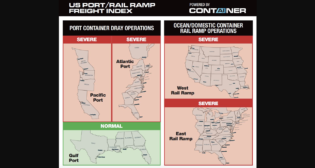
NS vs. CSX Recrews
Written by Rick Paterson, Managing Director, Loop Capital Markets
Some of these calculations may have well come from observing a black hole in deep space ... Shutterstock image.
In our prior report, we highlighted Ancora’s fraught and incurious NS vs. CSX operational benchmarking, specifically terminal dwell and trains holding for power. We took particular issue with the extraordinarily misleading 2023 dwell comparison—which was accepted as fact by Glass Lewis and likely ISS—where CSX’s number is based on a completely different measurement that effectively halves it. We had hoped to move on, but the invalid dwell comparison remains uncorrected on Ancora’s public slide deck as we rapidly close in on the proxy vote. So, let’s do another one…
Recrews
Here’s Ancora’s recrew chart from page 51 of its presentation:

The accompanying text reads:
“Since the Surface Transportation Board (STB) began requiring disclosure of weekly unplanned recrews beginning in May 2022, Norfolk Southern has averaged more than 4.3x the number of unplanned recrews relative to CSX, despite having >800 more train and engine service employees.”
4.3 times. Sounds bad, man. Let’s dig into it …
If the railroads all do this differently, and the differences aren’t known, then by definition these metrics are not credibly comparable—which is why we never do it, unless we’re forced to during stupid proxy contests.
Rick Paterson
We’ll start with the sniff test, and long-time readers of this report, who should know enough to be dangerous by now, will immediately see a couple of issues with the CSX line in the chart. First, 100 recrews a week just looks unusually low for a Class I railroad. Second, the trend line between May 2022 and December 2023 is suspiciously flat, given CSX melted down in 2022 but quickly recovered to be the best running Class I in North American in 2023. Hmm …
Let’s take a broader view and include the western railroads. They’re double the size of CSX and NS, so we need to divide recrews by an activity denominator to adjust for scale (we can’t use recrew rate because CSX used a non-standard definition of that). Ideally, we’d use train-miles, but we don’t have that on a weekly basis. The railroads did, however, report car-miles per week in 2022 and 2023, which is good enough.

The reporting of recrew data was discontinued by the STB in 2024, so the first four columns in our chart show the back half of 2023, and follows the remediation of NS’s East Palestine bottleneck over the Fourth of July weekend.
From July through December 2023, Union Pacific averaged 3.3 recrews per million car-miles; BNSF and NS were a little under seven; and CSX reported just one per million car-miles. At that time, CSX was certainly running better than the other three (with deserved kudos), so logically its recrews would have been lower. But three times lower than a well running UP and seven times lower than BNSF and NS? It’s possible, but a leap of faith in our view. We also want to be clear that we’re not defending NS in this analysis (defending railroads is not in our DNA). 6.9 was too high.
The last two columns in our chart are also insightful. The second to last column shows CSX’s recrews when it was in a melted-down state between May 2022, when the data became available, and Labor Day weekend, when CSX slingshot out of its meltdown: just 1.6 per million car-miles.
The final column in our chart shows Canadian Pacific Kansas City’s U.S. operation for the exact same period, when CSX was melted down. At that time, CPKC was running well and certainly not in a meltdown state, and reported 1.8 weekly recrews per million car-miles. Where we’re going with this is that, to believe the CSX recrew number is credibly comparable to its peers, you also need to believe that—in the depths of a meltdown—it was somehow normal that CSX at its worst generated 14% fewer unplanned recrews than a best-in-class CPKC that was running well. Unlikely.
Wrap Up
Similar to the Trains Holding for Power analysis last week, Ancora may have assumed the CSX data is credibly comparable to NS. That’s likely not the case. Ancora is correct in terms of rank order—NS was materially worse than CSX and an industry laggard—but 4.3x is an unscrutinized exaggeration.
PS on CSX
We know we’ve been beating up on CSX a little bit over the past couple of weeks, so a final point for perspective: It’s a free country and CSX can define and measure these metrics however it likes, within STB-mandated reason. What looks funky on the outside may, somehow, make sense internally in terms of how CSX thinks about and manages business. Our main point is comparability. If the railroads all do this differently, and the differences aren’t known, then by definition these metrics are not credibly comparable—which is why we never do it, unless we’re forced to during stupid proxy contests.



